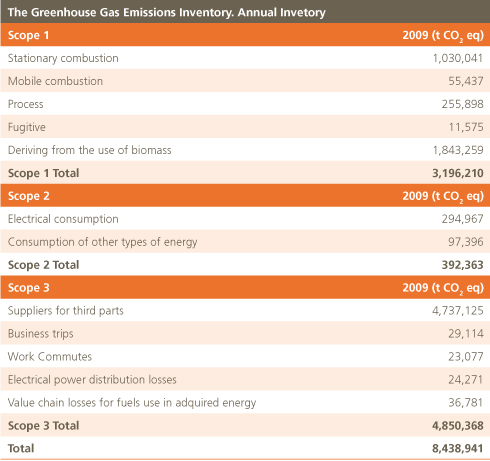 Abengoa
Abengoa
Annual Report 2009
- Corporate Social Responsibility Report
- Greenhouse Gas Emission Inventory
- Abengoa's policy on Halting Climate Change and Global Emissions Accounting
Climate change is an unquestionable scientific reality that has been brought on by human activity. The Kyoto Protocol therefore established the target of achieving a 5% reduction by 2012 of the 1990 Greenhouse Gas (GHG) emission levels of the world’s developed countries.
GHG emissions are related to industrial activity. Therefore, the countries with the highest degree of industrialization are those with the highest emissions levels. Lowering these emissions without affecting GDP requires, among other initiatives, the development of clean industrial technologies, substitution of fossil energy consumption for renewable energies, and modification of citizens’ consumption habits. This poses a challenge not only for governments, but for businesses and citizens alike.

Photo taken by Si Liu, from Telvent, to the 1st Edition of the Abengoa Sustainability Photography Contest
Agenda 21 of the United Nations establishes a comprehensive blueprint of action to be taken in facing the challenges of the new century through the integration of development and the environment.
The role of the business community in the struggle against climate change is synthesized in managing clean production and promoting responsible engagements, and is implemented through a range of actions:
- Management of the knowledge of an entity’s own emissions: emissions accounting and balance sheet, with traceability to the different inputs.
- Plan for reducing and minimizing emissions, raw materials and inputs utilized, as well as waste and discharges, through suitable management.
- Product labeling.
- Analysis of product and business life cycles, including assessments of the potential for improvement.
- Innovation.
- Alignment of new businesses with sustainable development.
- A business can voluntarily become a neutral emitter by purchasing carbon funds to compensate its emission balance.
In keeping with the above, in 2008 Abengoa implemented the inventory of greenhouse gas emissions for its activities conducted worldwide in order to gain in-depth knowledge of the direct and indirect GHG emissions associated with each company activity, evaluate the situation, and identify improvement options.
Abengoa’s emissions accounting system is a pioneer in the inclusion into the inventory of emissions derived from goods and services acquired for carrying out its activities. Abengoa suppliers, representing a figure which now totals more than 14,000, have added their own pledge to the company’s commitment to perform accounting of their emissions in order to report them each time they submit an invoice to Abengoa companies throughout the world. This not only enables Abengoa to obtain exhaustive global emissions accounting, incorporating Scope 3 of the GHG Protocol, but also promotes the company’s commitment to the most progressive policies for combating climate change and its impacts.
The results of Abengoa’s 2009 GHG inventory, then, constitute a complete picture of the greenhouse gases associated with the company’s activity, structured around scopes and sources, differentiating and including emissions deriving from biomass operations, and disclosed publicly in order to facilitate reflection and comparison to other companies that place climate change policies at the core of their activity and interests.
Thus, the inventory enables Abengoa to progress in two undertakings in which the company is deeply immersed: rigorous reduction target-setting for lowering the company’s carbon footprint, and stringent product labeling, providing reliable, contrasted and verified information to the market and society. Both developments and its results are going to be published along 2010.
